

Tantalum (Ta) is a rare and highly valuable metal known for its excellent corrosion resistance, high melting point, and unique electrical properties. It plays a critical role in various high-tech applications, particularly in the electronics industry, where it is used in capacitors, semiconductor devices, and mobile phones. However, the increasing demand for tantalum, coupled with the depletion of primary sources, has prompted a shift towards secondary sources and recycling efforts.
The demand for tantalum has surged due to its vital role in modern technology. With a current end-of-life recycling rate of less than 1%, the tantalum industry faces significant challenges as traditional sources of tantalum are being depleted. The Covid-19 pandemic highlighted the vulnerabilities of global supply chains, making it urgent to develop new secondary sources for tantalum recovery.
The industrial community is increasingly focusing on the recovery of tantalum from secondary materials, particularly electronic waste (WEEE). The Global E-waste Monitor reported that in 2016, approximately 44.7 million tons of e-waste were generated, with the concentration of valuable metals in this waste being 10–100 times higher than that found in ores. Despite this potential, only 20% of e-waste is currently recycled, and tantalum accounts for just 1% of that total.
Recycling tantalum from WEEE involves several challenges:
To improve recovery rates, dedicated methods and processes need to be developed. Current industrial-scale tantalum recycling typically uses high-purity materials like production scrap, cemented carbide, and superalloy scrap. Processes such as remelting in an electron beam furnace and dehydrogenation in a vacuum furnace are commonly employed for unoxidized tantalum scrap, while oxidized materials are treated with acids following roasting.
Innovative recycling methods for tantalum capacitors have been explored to improve recovery rates from electronic waste. These methods can be categorized into three main approaches. The first involves Identification and Liberation techniques. Artificial treatment offers high accuracy but comes with significant costs, while automatic disassembly is efficient but may lack precision. The second category, Physical Processing, includes mechanical processing, which is straightforward but tends to yield low separation rates. Pyrolysis is another method in this category, providing high separation efficacy but at the expense of high energy consumption. Other techniques, such as ionic liquid treatment and supercritical water processing, are also under investigation, though they similarly require substantial energy inputs. The third approach, Metallurgical Processing, encompasses hydrometallurgy and pyrometallurgy. Hydrometallurgy is a longer process but can achieve high purity levels, whereas pyrometallurgy is more rapid but demands significant energy. Recent advancements suggest that combining these techniques may enhance the purification of tantalum. Furthermore, innovative mechanical treatments, including promising cryogenic methods, are being explored to improve efficiency while minimizing environmental impacts..
To ensure a sustainable supply of tantalum, several strategies should be considered. Establishing long-term offtake agreements can help secure supply through partnerships, while diversifying the tantalum supply chain across various geographic locations can mitigate risks. Additionally, enhancing recovery techniques and processes will be vital in increasing tantalum recycling rates. The tantalum industry is encouraged to embrace new technologies, particularly in metallurgy, to drive these improvements. Although hydrometallurgy currently dominates tantalum production, there is a pressing need to explore alternative processes that reduce reliance on harmful chemicals, such as hydrofluoric acid. This shift is critical for the sustainable development of the tantalum sector..
Tantalum is a critical metal in the modern technological landscape, but its production and recovery face numerous challenges. The transition toward secondary sources and effective recycling processes is vital to meet the growing demand while ensuring environmental sustainability. By investing in innovative recycling technologies and diversifying supply chains, the tantalum industry can better navigate the complexities of resource management and secure its future. Ongoing research and development will play a crucial role in enhancing the recovery of tantalum from e-waste and other secondary sources, paving the way for a circular economy.
Arnold, B. (2022). Zircon, Zirconium, Zirconia-Similar Names, Different Materials. Berlin/Heidelberg, Germany: Springer.
Stawarczyk, B., Keul, C., Eichberger, M., Figge, D., Edelhoff, D., & Lümkemann, N. (2017). Three generations of zirconia: From veneered to monolithic. Part I. Quintessence international, 48(5).
Bruhnke, M., Awwad, Y., Müller, W. D., Beuer, F., & Schmidt, F. (2022). Mechanical properties of new generations of monolithic, multi-layered zirconia. Materials, 16(1), 276.